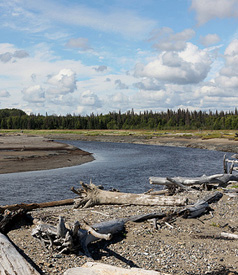The Carrs grocery store in Anchorage is always bustling at 7am on a Saturday in August. SUVs and pickups with boats in tow crowd the parking lot, and bleary-eyed men and women stand on line at the coffee bar clad in Xtra-Tuff rubber boots and Carhartt jackets. This is Alaska.
I lean over the refrigerator case and grab a twin-pack of hard-boiled eggs in a small plastic box. “You goin’ fishin’?” a burly, moustached man asks me with a twinkle in his eyes. Sensing my confusion, he points at the eggs, “That’s boat food!”
I laugh. “It’s airplane food, actually,” I explain. “I’m flying across the Inlet today.”
He knows because he lives here that I’m not talking about a big commercial flight. I’ll be flying in a small prop plane, and landing on some gravel bar or beach or air strip. He asks the next logical question, “Silvers?”
It’s silver salmon season, and most of the boats in the parking lot are on their way to bring their owners to rivers, streams and bays for the annual ritual – conquest and consumption of the delicious and acrobatic fish. Silvers are as much fun to catch as they are to eat.
“No, I’m doing a fly-over of the proposed site for the Chuitna coal mine,” I explain. Blank stare. I can tell right away that like most Anchorage residents, he has not heard of the massive development project just across the body of water that he sees every day. I’ve also now broached the subject of mining, which means that the “jobs vs. tree huggers” meme has just been introduced into this early morning conversation. Alaskans love pristine wilderness, but many also have an paradoxical aversion to “greenies,” which are loosely defined as anyone who thinks they know what’s best for other people at the expense of “progress.” It’s a reckless move on my part, but I’m too sleepy to overthink it, so I lay my cards on the table.
“The point is to keep it so people can continue to go fishing over there, and so there will still be fish to get,” I smile.
“Well, good luck,” he says with raised eyebrows, and an expression I couldn’t read. Was he just being polite? Had he pegged me as a “greenie?” Did he roll his eyes behind my back? I wasn’t sure.
But ten minutes later when I was standing on the coffee line waiting to pay for the eggs and a 16 oz. cup of the black stuff, I heard his voice again over my shoulder. He spoke slowly and deliberately. “I just wanted to say good luck again.” He looked me right in the face. That one I could read. He’d thought about it, and in the wee hours of the morning on a Saturday in the grocery store, he decided that fish were more important than coal. One down – thousands more to go.
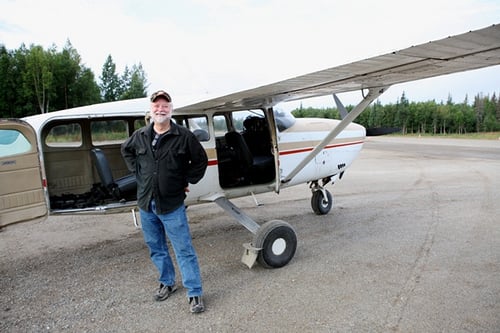
Half an hour later the engine of the six-seater single-prop Cessna 207 roars to life at Merrill Field. We lift off effortlessly and bank to the left, heading across the silty grey-blue waters of Cook Inlet – home to commercial fisheries, endangered beluga whales, and small coastal communities. A mere 20 minute flight from Anchorage and you are in a different world – Alaska’s largest city on one side, and complete wilderness on the other. The Inlet is flanked on both sides by mudflats of flour-fine glacial sediment in which tides have carved branched channels and rivulets that look like the impressions of great gnarled trees. In late August, the light begins to take on a golden quality, and leaves and tundra have begun their gentle change from the emerald green of summer to the burnished yellows, and deep reds of fall.
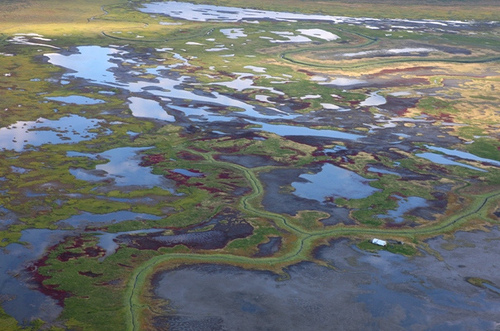
My mission today, with filmmaker Zach Roberts, is to help with the preliminary work for a documentary film about the biggest environmental issue in Alaska that no one has ever heard of. PacRim Coal, a Delaware company funded by Texas investors, and Barrick Gold, headquartered in Ontario Canada, combined hold leases to about sixty thousand acres of land (much of it coastal, riverfront, and wetlands) that promise to yield an estimated 1 billion metric tons of low-quality sub-bituminous coal that will be strip mined, crushed, shipped to Asia, burned and returned to Alaska in the form of acid and particulates that will ride the prevailing winds back across the Pacific to rain out on ocean, field, stream and forest of the land from which it came. Such will be the circle of life for this particular fossil fuel. The Chuitna coal mine would be the largest in the state, and the first large-scale mining operation in Alaska to be permitted to mine directly through a productive salmon stream.
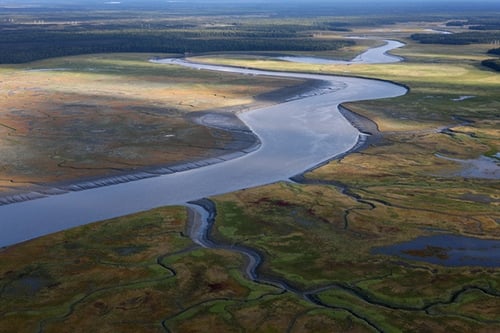
The plan today is to fly across the mouth of the Chuitna River and upstream, seeing where the huge pyramids of coal will sit, where the conveyor belt will run to the giant offshore island that will load coal on to ships bound for Asia, and what areas will be affected by the massive development project, as the toxic byproducts of the mine make their way into the waters of Cook Inlet.
Mark Bledsoe is our pilot. Tall, frosty beard, baseball cap, jeans and a belt. Affable, and just as twinkly-eyed as my hard-boiled egg man, he’s been briefing us about the conditions as we fly, and talking on the radio about the cloud cover. Little puffs of cotton ball clouds start to pass the windows at an ever-quickening pace until he declares, “Whoa. We’re turning around.” This part of our trip will wait until this afternoon when, Mark assures us, the clouds would burn off.
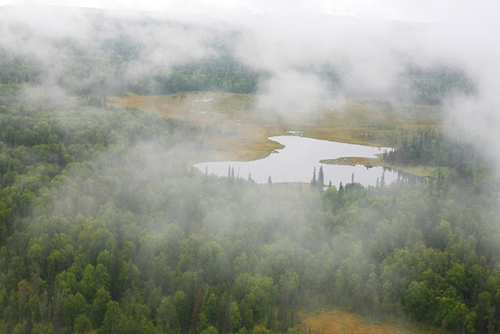
Our other flight companions are Ron Burnett and his wife Bobbi. They’ll act as our tour guides for the day. Owners of a cabinet shop in Anchorage, they have a home in the little town of Beluga (population 23) which extends to the shore of the Chuitna River. Ron says they have plans to retire there, “if we don’t get choked out by coal dust” – an understandable caveat. Ron is a pilot himself, and adds to the ranks of twinkly-eyed men that are populating my day. It soon becomes apparent that he knows this area like the back of his hand. He names every ridge, every river, every rivulet, and every lake. “That’s Goat Lake,” he says. “It didn’t have a name, so we gave it one. Roger Weber used to have goats, and he’d bring dead ones over to the corner of the lake, for the coyotes and the wolves to eat.” He chuckles, and I think that’s as good a reason as any to name a lake. Bobbi, a quiet, observant redhead sits in the back seat, easily spotting moose out the window and pointing them out as we pass overhead.
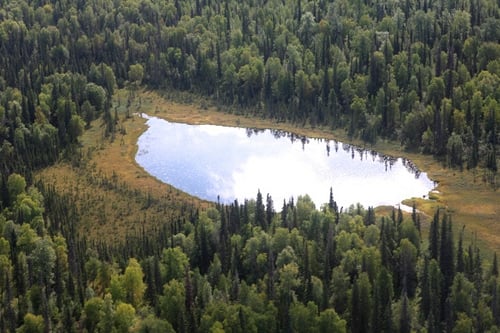
We touch down as smooth as butter on the gravel airstrip in Beluga. “You’ve done this before, haven’t you?” I say into the microphone on my headset. “Nope, this is my first day,” Bledsoe teases. “You’ve just never had survivors,” jokes Ron Burnett, and we all laugh. Mostly.
The propeller sputters to a stop, and we step out. There’s a long row of battered and beaten vehicles that look like they’ve been work-horsed almost to death. At the end of the row is a sign that says “No Vehicle Parking.” “Nobody pays attention to the sign,” says Bobbi.
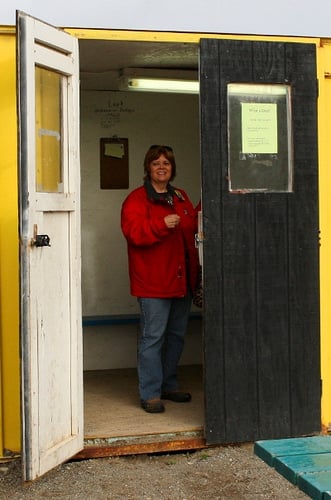
Ron goes to the lineup and grabs our ride – a big brown extended cab pickup with large cracks across the windshield that looks like it’s been through a war that ended before I was born. “This is Beluga Brownie,” he says with affection. “Picked it up 19 years ago for 375 bucks, and it still starts every time.” That’s all that counts in rural Alaska. This is a no-frills place, where the only question that needs answering is, “Does it work?” The elements are not kind to things made of metal, and functionality is the rule. In this world, Beluga Brownie is a treasure.
A bouncy 10 minute ride later, winding around muddy potholes, we arrive at the Burnett’s cabin. Large sculptured pieces of driftwood ring garden patches of wildflowers. The doormat next to the porch swing proclaims “Proud to Be American.” This is a cabin they’ve built themselves, starting out with one room, a loft and an outhouse. Now, 17 years later it sports a state-of-the-art kitchen, a guest room, indoor bathroom, and master bedroom. Antlers, a bear skin, and a stuffed marten weave into a motif of Ebay antiques, giving the place an eclectic feel.
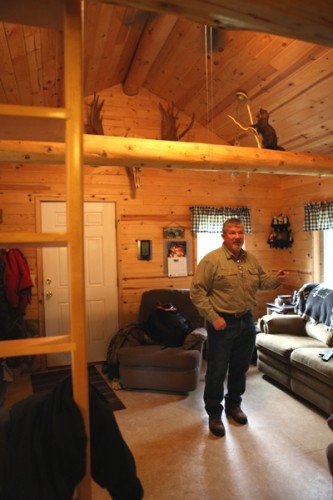
Where Terry Jorgensen fishes is one of the only areas of deep water nearby. Now, PacRim plans to build a 400×600-foot metal island to offload coal exactly one foot from where his lease ends. “This coal company” as Jorgensen calls it, is ready to put a conveyor literally right over his head. Right on the beach where he fishes, he says, there will be huge pyramids of coal weighing 500,000 tons each that will sit and wait for super tankers to haul them to China.
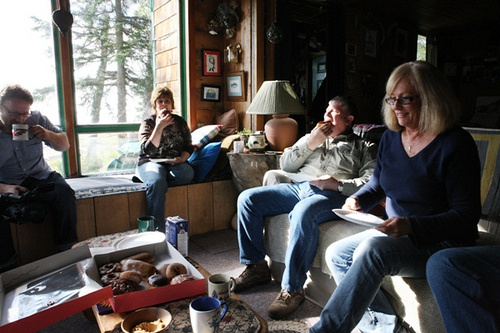
Zach Roberts, the Burnetts and Lynn Jorgensen
“They admit that all the beaches will be black, and the neighborhood will be black. There’s no way around it.” Jorgensen sounds tired. “What most of us are worried about is the river. The Chuitna River is worth saving. A third of the water that goes into the river is going to be diverted or pumped out every day and that’s just going to destroy it. So for the Tyoneks who subsistence fish on that river, and all the locals who fish on that river,… that’s what’s got us the most concerned. Jeez…why are we going to mine through salmon streams?” There are answers to that question, of course, and they all involve corporate profit, but none of them are answers people on the side of the fish want to hear.
Pac-Rim has promised that when it’s all over, they’ll clean it all up and stock the river with more salmon and it will be “even better” than before, Terry Jorgensen tells me. Lyn adds, “That’ll be about 100 years from now.” Little comfort, especially considering there’s no record of that type of restoration ever having happened before.
The conversation turns to the burning of fossil fuels, climate change, and ocean acidification, and then swings back around to individual liberty, the right to live where you want, the right to have a place and call it yours, and brooding dissatisfaction with local politicians, government agencies, and corporations that put profits before people.
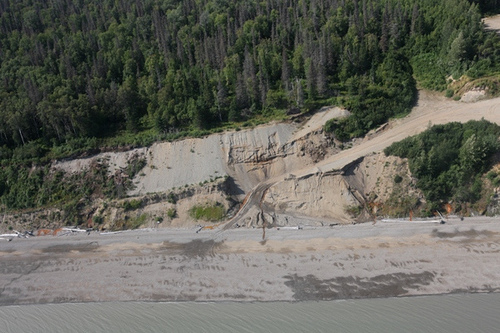
The path to the beach by Terry Jorgensen’s fish site
On the other side of the river is the Native village of Tyonek (population 199), “All the people that have lived there for generations – this will probably be the demise of them,” says Terry, his head down. “I’ve heard their comments – If this goes in, it’s poison. We don’t want to live where there’s poison. It’s sad. They’ve lived here a long time.”
After the Exxon Valdez oil spill, the commercial fishing industry in Alaska crashed, even in areas like Upper Cook Inlet that were unaffected by the spill. Nobody wanted Alaskan fish, and prices went through the floor. The Tyoneks traditionally held about 25 commercial fishing permits before “Exxon put everybody out of business,” says Jorgensen. “And like most coastal people, if you don’t have commercial fishing, you don’t have employment. There’s nothing to do. You either work for government or you work with the fish. And what’s great now, in the last three years, we finally got the tenders back. The price of fish is up a lot, compared to what it was. I think there were up to 14 of them out this year, and they’re so happy to be fishing. One night, I was waiting to unload, and a Tyonek boat came up, full of kids. One girl was maybe 15, big smile on her face, and her Dad’s been catching all these fish… If you go and talk to them, they’re so happy. To us it’s making money, but to them it’s a whole bunch of things we don’t understand very well. And that was the happiest boat.
“This is a very sad village,” he went on, “Eight years ago the Chief said that the only thing growing in the village was the cemetery, because so many kids were killing themselves, and he was so sad. He died a few years later. I’ll never forget him saying that – ‘My God, this is such a tragedy.’ And now, they’re very hopeful. They’re processing some fish, they’re using the tenders, we’re talking about trying to put a hatchery in Tyonek and working with aquaculture. Those are very positive things for year-round employment at the hatchery. And they’ve got some money – and this mine will pretty much take all that away. It’s pollution right on top of where they’re fishing, and right out into Cook Inlet.”
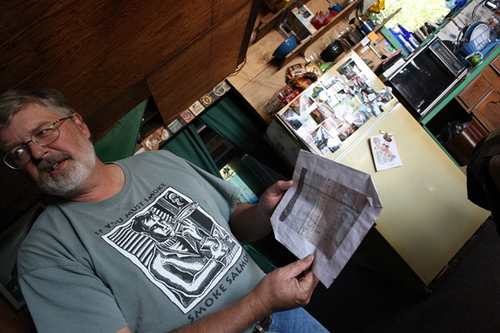
Terry Jorgensen
As the Jorgensens talk more about what their land will look like, and the noise of the helicopters that disrupts the normal patterns of the beluga whales, Terry gets up to show me a letter he received from a professional land manager, on behalf of PacRim. He reads it aloud, “During a routine examination of the relevant State of Alaska Department of Natural Resources Case File, it appears that you will need financial assistance in displacement costs relative to locating a new site.”
He shakes his head in disbelief. “So, I called this guy up and told him we didn’t want to move.”
“This has been going on for quite a while,” ponders Lyn, “and it still hasn’t reached a wider audience, and that amazes me, because it’s so close to home,” referring to the fact that this area is so close to Anchorage, which boasts about half the population of the state. “But nobody seems to know anything about it. You ask people in Anchorage and they say, ‘Huh? Where’s that? Never heard of it.’ Nobody seems to register that this is actually going to happen, unless they shout about it.”
The lease area for the first phase of the project, I learn, is almost as big as the entire Anchorage bowl, and the pit will be mined 350 feet deep.
Ron dutifully checks his watch and tells us it’s time to move on.
Next stop is the home of Larry and Judy Heilman. Three dogs run over to greet the six-wheeler, accompanied by two kids. Chasity Wilson (7) is a young student of Judy’s, and Anson (16) is their grandson. They both smile and shake my hand.
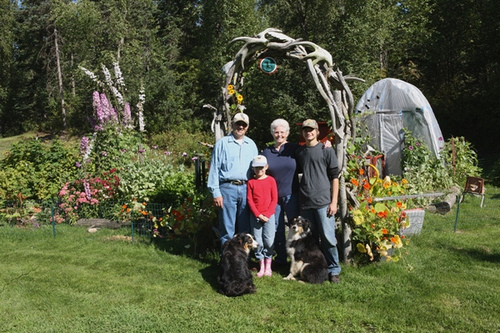
The Heilman Clan by the garden
We get a tour of the gardens, which are breathtaking. Vines of orange trumpet flowers climb arches and trellises. The hum of insects is everywhere but happily they all seem far more interested in the flowers than the humans. Chickens cluck in their coop. Purple poppies and larkspur bloom, and Judy wonders aloud if her second crop of lettuce will make it before frost. “Worth a try,” she says with an optimistic smile that lights up her face.
The Heilmans have lived here for decades now. “We’ve got a lot of blood, sweat and tears in this place,” Judy tells me. Their house is about 2 miles from the proposed conveyer belt, and nine miles from the location of the open pit. Forty percent of the area of the open pit location is considered wetlands. “When they went up there looking for gravel, they couldn’t dig for 10 feet anywhere around without hitting water,” Larry says. Further exploration of the area early in the year revealed the existence of artesian wells. In order to mine the coal, the heaviest deposit of which is 350 feet below the surface, PacRim will have to “de-water” the area down to 400 feet, to allow equipment in. PacRim says that the project will affect the water table as far as fifteen miles away from the pit in every direction. Not only will the shallow wells that residents use be affected, but so will the entire watershed of the Chuitna River. Almost eleven miles of productive salmon stream with strong runs of king salmon and silver salmon will be completely wiped out by the mine.
And it isn’t just the local fish in the Chuitna area that will be affected, Larry reminds me. Local sport fishermen and tourists flock, every year, to rivers up the inlet – the Deshka, the Little Susitna, the Yentna, the Talkeetna, and dozens more.
“All those fish will have to come past Tyonek, through the polluted water that comes down into Cook Inlet. All those fish will have to swim through this ‘mixing zone.’ Are they going to make it? And then they have to swim back to spawn.” I wonder how excited sport fishermen and tourists will be to spend the money on fishing licenses, gear, and even plane tickets to come catch salmon that have been swimming through a bath of hydrocarbons and toxic runoff.
“You’d think the fishing industry would really be hammering this,” Judy muses. They’re not. Yet. We’re working on it.
“And what’s going to happen to the children in Tyonek? They don’t have a way to get out. I always think about the kids. What are they going to do?”
The Tyoneks tend to keep to themselves, says Larry, but lately there has been more communication with those on the other side of the river that is shared by the two communities, and whose fate affects them all.
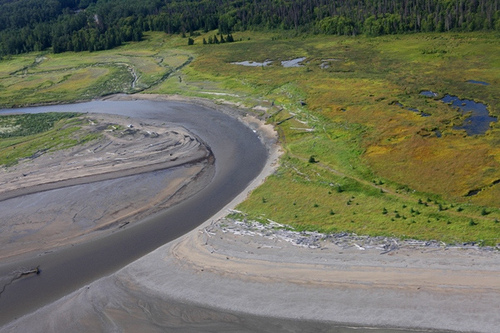
The mouth of the Chuitna River
“We get the feeling from them that they are getting more and more concerned and scared that their way of life is getting ready to go out the door if this goes through,” says Larry. “Why eliminate salmon for coal? Think over the years how many hundreds of people that river has fed, and how many hundreds of thousands of people it will feed if it’s just left alone.”
The Heilmans have sent many letters and emails to the men at the top of this coal pile, Richard Bass and Hubert Hunt, the wealthy Texas investors who own this project. So far, they haven’t heard back. Bass in particular seems to have inspired anger from the residents here. He’s been here several times, and even visited the little general store. But never has he done what Zach and I are doing today – talking to people.
Bass owns the Snowbird Ski Resort in Utah, which has more than a million visits a year, and he has been the recipient of several awards for environmental excellence as it relates to the resort. An outdoorsman, Bass has climbed the highest peaks on all seven continents. The Sheldon Coleman Great Outdoors Award, one of a long string of awards he has received is “presented to an individual whose personal efforts have contributed substantially to enhancing outdoor experiences in America.”
Those in Beluga note that this project will surely not “enhance” the outdoor experience of anyone. There is an ongoing effort to urge Bass to divest his interest in the PacRim project, and spend his money instead on some kind of energy project that won’t devastate communities, the environment, and the salmon.
It’s obvious that Judy Heilman takes it personally.
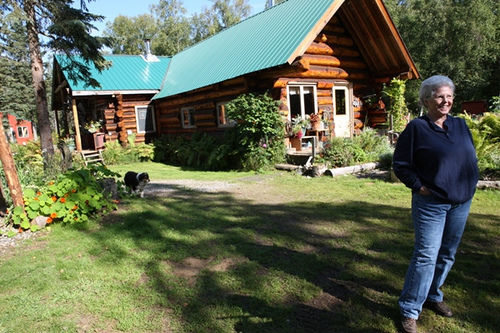
“In his area down there he gets environmental awards all the time. Why can he come up here and dirty our back yard?
“In our back yard we’ve got plenty of energy. We’ve got gas, we’ve got thermal, there’s tidal out here in the Inlet, if they would just get their butts in gear. Put their money there instead of putting it in this dirty energy. It’s just because politicians and the dirty coal guys are shaking hands – got their hands in each other’s pockets, and they just won’t let go. It’s got to change. Us little guys all know it. Why in the Hell don’t the big guys know it? Why don’t they do something about it? They. I guess we are the they. We need to do it. We are the they, I guess.”
The Heilmans, and the other people I’ve met today have been trying to get the message out. They’ve talked about the subject of this mine a lot. They’ve answered many questions, but I can tell they’ve never answered the one I ask next as Zach films.
“So, if Richard Bass ends up seeing this, since he’s not answering your emails, what would you tell him?”
The Heilmans both laugh, imagining the scenario. And then Judy goes silent and thinks for a moment. What would she tell him? She levels her eyes at the camera and speaks to it as though she were sitting in a chair across the desk from Richard Bass in his office at the Snowbird Lodge.
“Mr. Bass you’re a big damned hypocrite. How in the hell can you sit down there in your fancy house and your Snowbird Lodge, and get these awards and not even come up here and see how its going to affect our lives and our area? How can you think that this is the right thing to do – to ruin a salmon stream, ruin the fish, the water and the air. And how many people’s lives will be affected by it? And you sit down there and you can’t even answer a damned letter?” Her voice trembles, her eyes have filled with tears of anger and frustration, and she turns and walks away from the camera for a minute.
After she collects herself, she goes on – “Do these little children, these kids who are being raised here… do they mean anything? He’s got grandkids. Would he want that in his back yard? Does he want his grandkids breathing the coal dust and having to quit fishing in the rivers next door? I just think that families are damn more important than putting coal in the rivers and in our lungs.”
She loves this place with desperation, and it shows.
The people in Beluga are here because they choose this life – living in tandem with the elements, where gas is $6.50 a gallon, and if you want eggs for breakfast, or chicken for dinner it’ll take more hands-on involvement than picking up a package in the grocery store. They, and their neighbors in Tyonek have a relationship with the land, their homes, the weather, the fish, the berries, that many of us will never know.
Our next stop is Three Mile Beach by the Jorgensen’s fish site, and the mouth of the Chuitna River. We take off in a pack of ATVs. Bobbi puts the rig in low gear as we slowly descend a path through a steep cut in the bluff to the beach. Lumps of coal are easy to spot, eroding out of the sandy walls of the bluff. Chuitna does not keep its secret well. Down the white sand beach we go, zipping over large patches of colorful pebbles that make a sound like sizzling bacon as our tires pass over.
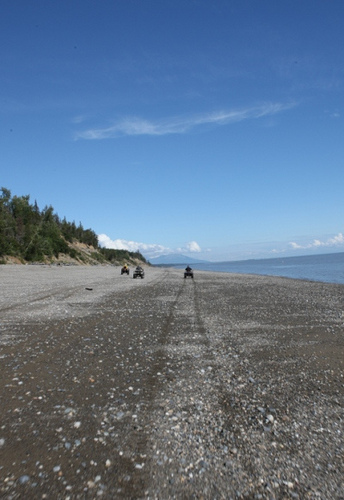
The day is perfect. It’s been a record summer for rain but today there is sunshine, cool breeze, and as we come to a stop and turn engines off, we hear the simultaneous sound of gentle waves and gentle slow river. Bobbi tells me that Ron likes to come to the beach and look for agates among the pebbles. They also come here for picnics and cookouts, and to just be. Small planes land on this beach when the tides are right, and the pilots and passengers fish the Chuitna. I tell them I can’t think of a better place to do it. Chasity is busy looking for interesting stones, and her job is easy. We start comparing. I find a pink one that matches her rubber boots. She finds a square one, the color of a chalk board. I tell her that I’ve heard that the grey ones with one white stripe are lucky. Her eyebrows go up.
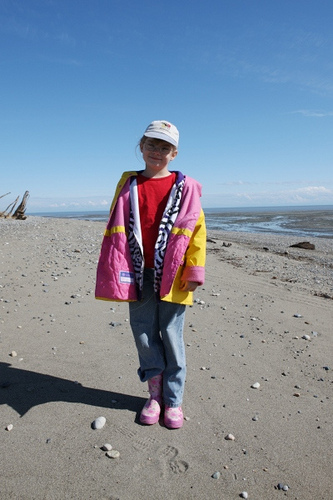 Larry walks over, and I remark on the beauty of the spot. “Now remember,” he says and sweeps his hand across the view, “this is all going to be black.” I feel like I’ve just been doused with a bucket of frigid Cook Inlet water. For a brief moment, it was just a day on the beach, and I’d almost forgotten. But, yes – this will all be black. The sand, the stones, the trees and the river, and no children will be able to tell the difference between agate and basalt, and nobody will have barbeques, or race down the beach on four wheelers. And nobody will be fishing here for sport, or for their livelihood, or for their survival.
Larry walks over, and I remark on the beauty of the spot. “Now remember,” he says and sweeps his hand across the view, “this is all going to be black.” I feel like I’ve just been doused with a bucket of frigid Cook Inlet water. For a brief moment, it was just a day on the beach, and I’d almost forgotten. But, yes – this will all be black. The sand, the stones, the trees and the river, and no children will be able to tell the difference between agate and basalt, and nobody will have barbeques, or race down the beach on four wheelers. And nobody will be fishing here for sport, or for their livelihood, or for their survival.
I’ve got one of those lucky rocks that I’ve been holding in my hand, and I show it to Chasity who admires it. “You know what you should do? You should throw it in the river for luck.” She gives me a shy smile. “How about making a wish that this place never changes, and that it stays this beautiful forever. What do you think?” She looks up at me with approval as I put the stone in the palm of her outstretched hand. She crunches through the pebbles to the edge of the river and throws it hard. She looks back at me after it makes a satisfying kerplunk. “That’s a good start,” I say, hoping I’m right. If I’m wrong, toxic runoff and mine waste will pour into the Chuitna, over Chasity’s lucky rock, and out into Cook Inlet at a rate of 7 million gallons every day.
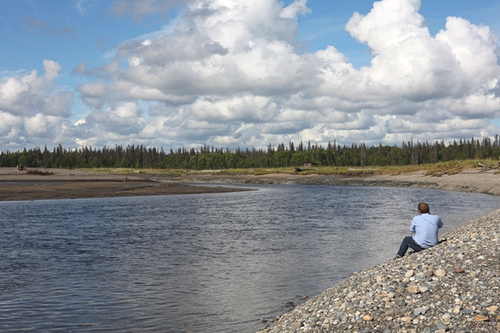
Zach Roberts photographs the Chuitna
I look across the Inlet to the Anchorage side. I feel like someone on the moon looking back at Earth. I can see across Cook Inlet from my kitchen window, and now I can pinpoint exactly where my house is from this beach. I’ve often washed dishes and looked across to this side, wondering what’s over here. Now I know. And then I realize that I, like most of Anchroage, will be able to actually see the effects of this mine every day.
As we leave the beach and head back up the steep path, we stop for a moment to grab a couple pieces of coal. I look at the shiny black lump, and feel sad that this beautiful place is cursed. Back at the Heilman’s house Judy has laid out a spread fit for a king. Raw vegetables, sliced reindeer sausages, cheddar goat cheese from the Mat-Su Valley, crackers and homemade smoked Chuitna river salmon dip. Dessert is a blueberry shortcake with wild berries right from the Burnett’s yard, topped with whipped cream. Heaven.
Ron checks his watch again and keeps us on schedule. “They’ve launched,” he announces, meaning that pilot Mark has taken off from Anchorage and is on his way to the airstrip to meet us. It’s time to leave.
“It’s hard to think about it every day,” Judy tells me as we head back to the six-wheeler, and she gives me a hug. “It can’t happen. Where would we go?” I have no answer.
Back at the airstrip Mark is there waiting by the plane. He asks how my day was, and whatever word I was looking for, I never found it. He loads our gear and we are airborne in a matter of moments. His prediction has proven true – the cloud layer has indeed burned off, and blue skies with high puffy clouds greet us as we crest the treetops.
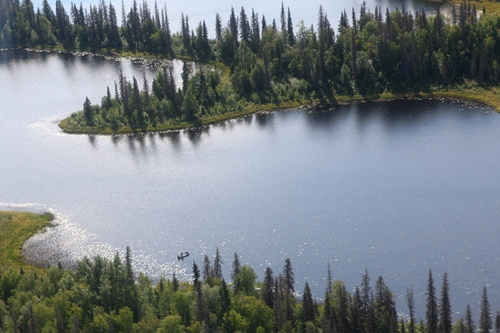
Vast areas of cottonwood, and spruce pass beneath us, and give way quickly to open marshy areas with stands of skinny water-loving black spruce trees. The theme of this place is water. It is everywhere, in every form, from the glaciers that hang on the Alaska Range to our right, to the waters of Cook Inlet that flank us on the left, and every creek and river and pond and lake and marsh in between.
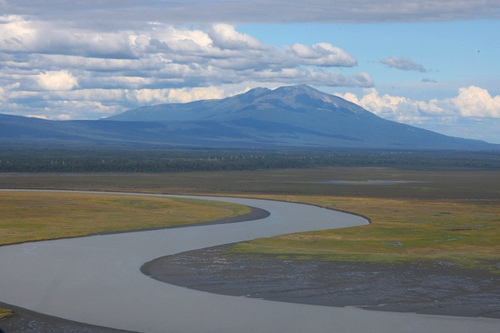
This coal deposit could not have picked a worse spot. The idea that anyone could “de-water” this place seems patently absurd.
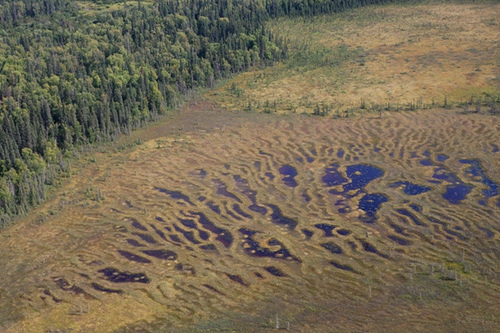
Ron gives us running commentary of where the conveyor will be, and where the massive island will be, and where the piles of coal will be, and where the pit will be. We bank right and cross over a breathtaking canyon where the Chuitna tumbles over huge boulders and bends snakelike between red bluffs and around little islands covered with spruce, and I think to myself that this is one of the loveliest places I’ve ever seen. “This is all Barrick Gold’s land,” Ron’s voice crackles over the headphones. It’s almost too much to bear, and this is only my first trip here. What must it be like for Ron who has fished and hunted and flown and camped on this land for so many years? What must it be like for the Tyonek people whose ancestors’ bones still lie in undiscovered burial grounds in this soil – in this “lease area”, and whose very lives depend on the subsistence harvest of fish, and game, and berries just like those ancestors have done for thousands of years? What must it be like for Judy, who worries about the children and thinks about the loss of her home every day, and Larry who walks the beach and imagines what it would look like black? And the Jorgensens who face the prospect of a conveyor belt over their heads dumping toxic coal that has an “escapement” into the environment of seven pounds per hour per acre of development? I think of Anson and Chasity some day telling their grandchildren that they remember the way it used to be.
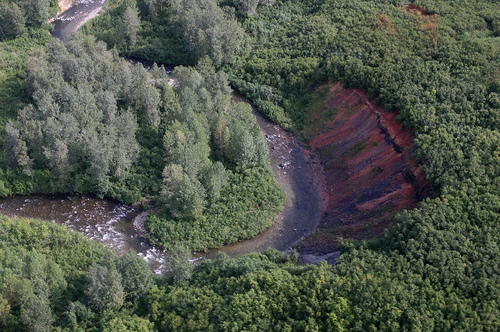
We pass over the houses I’ve just visited, and the beach I’ve just walked, and the mouth of the Chuitna, flowing slow and green; swirling in dark bands as the fresh water mixes with the salt water of the Inlet. We cross the wetlands and marshes that are a patchwork of color and water, and dotted here and there with hunters’ duck shacks. The mine is just a few miles from these wetlands, a critical stopover for hundreds of thousands of migrating waterfowl. What will the byproducts of the mine do to these coastal breeding grounds?
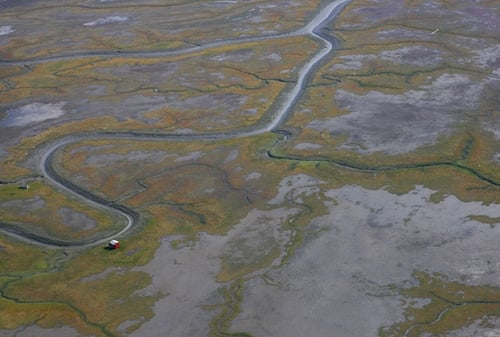
My brain is spinning, trying to process all I’ve learned and seen today. It isn’t that I haven’t read a lot about Chuitna, but sitting in living rooms and meeting people for whom this place means everything, has made it hit home hard.
Back we fly across the slate grey water, and in minutes we are back to civilization, passing over big tanks, and buildings and roads and the port of Anchorage. We pass by the BP building and baseball fields, and houses, and we touch down smoothly where we started – back at Merrill Field.
I recently saw a local elected leader with a button that said, “I (heart) Alaska’s Clean Coal,” and I now hear the words of Judy Heilman in my ears. “There’s nothing clean about coal. It’s dirty from the time they take it out of the ground, to the time they transport to the time they burn it. There’s nothing clean about it. It’s an ancient technology that needs to go.”
I give Bobbi a hug goodbye as Ron shakes his baseball-capped head and looks down at the ground. He asks the question that thousands have asked before – in West Virginia, and Pennsylvania, and the Amazon, and the Niger Delta, and anywhere that corporate resource development and greed has overpowered the will of local people – “Isn’t it amazing how you can love something so much, and someone else can come in and tear it up and they just don’t care?”
“Yes, it is,” I think, and I am overwhelmed by the few hours I have just spent in a place I look at every day out my kitchen window, but until now have never been able to touch.
“Now you write a good article,” he says.
*****************************************************
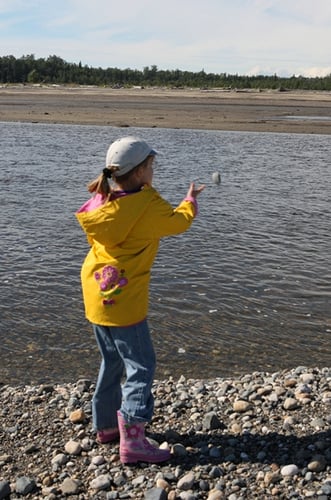
Chasity and the lucky rock.
Public comments on the proposed Chuitna coal project are being accepted for review by the Alaska Department of Natural Resources. Send comments to Russell Kirkham at [email protected] or to 550 W. 7th Ave. #920, Anchorage, Alaska 99501. Deadline is September 24, 2010.
For more photos of my trip to Beluga, see my Flickr page HERE.
*Please note that the Chuitna coal strip mine is not the CIRI Beluga coal gasification project. I am not commenting on that project, but want to avoid confusion for those who are unfamiliar with Chuitna.
Join us in defending the truth before it’s too late
The future of independent journalism is uncertain, and the consequences of losing it are too grave to ignore. To ensure Truthout remains safe, strong, and free, we need to raise $46,000 in the next 7 days. Every dollar raised goes directly toward the costs of producing news you can trust.
Please give what you can — because by supporting us with a tax-deductible donation, you’re not just preserving a source of news, you’re helping to safeguard what’s left of our democracy.
